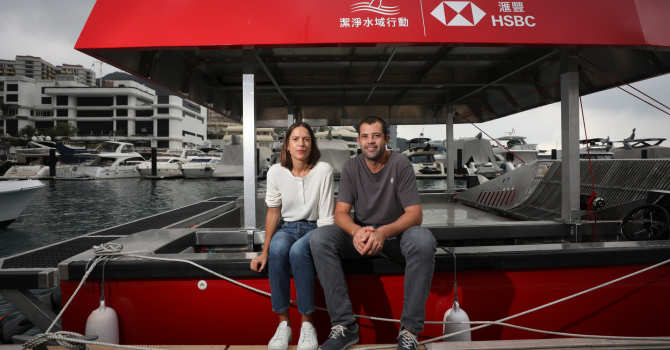Prioritizing environment over short-term profits in investment
Hong Kong is transitioning into a green financial center at a time when Asian economies have pledged to achieve carbon neutrality. The dominant economy, China, committed to achieving it by 2060; Japan, South Korea, and Hong Kong are aiming for 2050. Various central banks have also stepped forward with sustainability policies.
Asset owners are driving the sustainability revolution. Early green investors in Asia, such as Annie Chen, principal and chair of RS Group in Hong Kong, began thinking about how to invest for good 20 years ago.
Her portfolio aligns assets specifically to achieve sustainability goals. This included a divestment strategy in 2013 to remove fossil fuels, unsustainable utilities, and harmful exploration and production activities, and redeploy capital into renewable energy and other impactful projects.
Where many asset owners question the return of green investments, RS Group stated its investments in both public and private markets had generated a competitive if not superior return compared to the mainstream benchmarks over the years. Its success in green and sustainable finance is paving the way for other Asian asset owners to follow.
While more asset owners are refocusing “purpose and impact” alongside “return”, and some famous global hedge funds have committed to sustainability, a key factor lies in the attitude and capability of asset managers.
Managers are used to focusing solely on achieving high returns for clients. They need to also consider other factors at the same time. A genuine shift to sustainability requires building the capacity to understand what sustainability means so as to shape a credible portfolio.
Even though there isn’t a “green” standard in the market yet, Elsa Pau, Founder and CEO of WealthAsia Group in Hong Kong, created BlueOnion, an innovative digital platform curated for asset owners and institutional investors that provides data access to the constituents that make up their investments. The platform also helps investors and managers identify stronger investment funds.
While the science is clear that a rise beyond 1.5 to 2°C in global temperature will lead to more severe weather events, Pau pointed out up to 50 percent of the 70,000 funds BlueOnion monitors still contribute to increasing the global temperature towards a 3°C scenario despite having an alignment temperature score.
Pratima Divgi, Director of CDP, a global disclosure platform, urges financial institutions to investigate the portfolio-level risks and emissions that their investments and financial decisions generate. This will enable integration of climate-related assessments that can have financial impacts, negative or positive, on investment portfolios.
Disclosure on climate-related financial risks and opportunities will soon become the norm among Asian companies. The number of companies reporting on the CDP platform in the Asia Pacific region increased by 20 percent despite the pandemic.
Investors should realize that what may be perceived as having mid to long-term climate change impact could have an immediate impact on their investments. This is because climate risk is not yet priced in due to a lack of information on climate related risk. Once this new additional information flows to the market, there will be price adjustments.
Climate risk is universal but at the same time local as well as industry specific. In other words, location matters. Entela Benz at HKUST and co-founder of Intensel Ltd, a ClimaTech company, believes understanding the impact of climate change in specific locations is vital, such as whether assets are located in vulnerable areas.
Benz’s work bridges the gap between science, sustainability and finance, generating extensive models and datasets for companies to evaluate climate risks and run short- and long-term forecasts to make better investment and financial decisions.
Introducing this kind of technology can speed up the transition. But this calls for engagement at a governmental level, too. After all, protecting infrastructure from severe weather events like storms, landslides and floods requires public sector investment.
Looking ahead, Bénédicte Nolens, head of the Bank for International Settlements Innovation Hub Hong Kong Centre, is spearheading innovative projects to incorporate finance, climate change and technology. As banks begin to recognize the opportunities in green finance, green loans and green deposits can catalyze more capital for positive causes on a broader scale.
BIS Innovation Hub is exploring new-technology solutions, such as blockchain, to deliver green bonds to retail investors in small denominations, equipping investors with full disclosure and tracking transparency.
Nolens also stressed that environmental risk analysis of banking portfolios is still evolving. Banks will need to explore increased use of data and technology to systematically identify and measure environmental risks.
For example, high carbon assets, like a coal plant, may become stranded and suffer from credit or investment write-downs. Negative biodiversity impact and water and soil pollution risks are also rising in risk focus. Exposures can be in the corporate to which loans are extended or in which investment is made or in affiliates or in the supply chain.
The “brown to green transition” is a massive challenge for all economies, including in Asia. Achieving carbon neutrality in 30 to 40 years depends on regular and close engagement between the public and private sectors. This includes those in finance where cross-disciplinary learning will benefit the transition.
The economic vibrancy of financial centers depends on professionals who spur innovation. Hong Kong is fortunate to be populated by many changemakers, including women catalyzers.
This article is written by Christine Loh, chief development strategist, Institute for the Environment, HKUST and board member of CDP Worldwide, London; and also Jade Yung who is a freelance content and creative writer. She writes about innovation in multiple disciplines, including arts and culture, wellness and sustainability.
The article is published in China Daily https://www.chinadailyhk.com/article/160652



